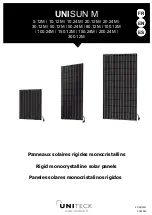
www.canadiansolar.com
| 7
Do not
install modules near naked flames
or flammable materials.
Do not
immerse modules in water or
constantly expose modules to water
(either fresh or salt) (i.e. from fountains,
sea spray).
· Exposing modules to salt (i.e. marine environments)
or sulfur (i.e. sulfur sources, volcanoes) incurs the
risk of module corrosion.
· Failure to comply with these instructions will void
Canadian Solar Inc. warranty.
INSTALLATION REQUIREMENTS
· Ensure that the module meets the general technical
system requirements. Ensure that other systems
components do not damage modules mechanically
or electrically.
· Modules can be wired in series to increase voltage
or in parallel to increase current. To connect modules
in series, connect the cables from the positive
terminal of one module to the negative terminal
of the next module. To connect in parallel, connect
the cables from the positive terminal of one
module to the positive terminal on the next module.
· Only connect the quantity of modules that corres-
ponds to the voltage specifications of the inverters
used in the system. Modules must
not
be connec-
ted together to create a voltage higher than the
maximum permitted system voltage, even under
the worst local temperature conditions.
· A maximum of two strings can be connected in pa-
rallel without using over-current protection device
(fuses…) incorporated in series within each string.
Three of more strings can be connected in parallel
if an appropriate and certified over-current protec
-
tion device is installed in series with each string.
· Only modules with similar electrical outputs
should be connected in the same series to avoid
or minimize mismatch effects in arrays.
· To minimize risk in the event of an indirect light-
ning strike, avoid forming loops when designing
the system.
· The recommended maximum series fuse rating
is stated in a table in the Annex.
· Modules should be safely fixed to bear all expected
loads, including wind and snow loads.
· A minimum clearance of 0.394 in (10 mm) or more
between modules is required to allow for thermal
expansion of the modules. The clearance is from
the plastic protect corner to adjacent plastic
protect connector.
OPTIMUM ORIENTATION AND TILT
· To maximize your annual yield, find out the optimum
orientation and tilt for PV modules in your region.
The highest yields are achieved when sunlight
shines perpendicularly onto the PV modules.
AVOID SHADING
· Even minor partial shading (e.g. from dirt deposits)
reduces yields. A module can be considered to be
unshaded if its entire surface is free from shading
all year round. Sunlight should be able to reach the
module even on the shortest day of the year.
· Permanent shading conditions can affect module
service lifetime, due to accelerated ageing of the
encapsulation material and thermal stress on the
bypass diodes.
RELIABLE VENTILATION
· Sufficient clearance (at least 3.94 in (10 cm)) bet
-
ween the module frame and the mounting surface
is required to allow cooling air to circulate around
the back of the module. This also enables conden-
sation or moisture to dissipate.
· Any other specific clearance required for main
-
taining a system fire rating should prevail. Detailed
clearance requirements pertaining to system fire
ratings must be provided by your racking supplier.
5.1
MODULE WIRING


































